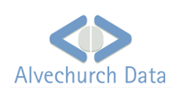|
VFP Tutorial - Build an Executable
![FoxPro Project Manager [Project Manager in Visual FoxPro]](./media/images/foxproj2.png) The last stage in the tutorial is to build an executable program. For this step we
need the FoxPro Project Manager back on the screen. If you are very careful with the
mouse then you can drag the Manager down from the toolbar but it is very easy to
drag a single tab instead of the whole manager. Being able to drag a tab
off the toolbar is a useful feature during form design but it's not what
we want to do at this stage. The easiest way to undock the Project Manager is
to right-click on the docked manager and select
from the menu that appears.
The last stage in the tutorial is to build an executable program. For this step we
need the FoxPro Project Manager back on the screen. If you are very careful with the
mouse then you can drag the Manager down from the toolbar but it is very easy to
drag a single tab instead of the whole manager. Being able to drag a tab
off the toolbar is a useful feature during form design but it's not what
we want to do at this stage. The easiest way to undock the Project Manager is
to right-click on the docked manager and select
from the menu that appears.
Click the button to display the project Build options.
Build Options
The standard version of Visual FoxPro lets you build executables and DLLs
which can be freely distributed without paying additional licence fees.
Select the option
and select the tick box.
Then click to build the executable.
![Build Options dialog in the FoxPro Project Manager [Options to build an executable in Visual FoxPro]](./media/images/foxbuild.png) You will be asked for the name of the executable. The default is for the
executable to have the same name as the project and to be in the same
directory but you can override both these options.
You will be asked for the name of the executable. The default is for the
executable to have the same name as the project and to be in the same
directory but you can override both these options.
If you have and the project has been built before
then you will be asked whether you want to overwrite the existing file.
The FoxPro development environment is not a verbose one. The cursor will
change to an hourglass when the build starts and you may see progress
messages flickering in the Status Bar as the build proceeds but that is
all that will happen. There will be no message to say that the build has
succeeded. If the cursor returns to normal without there having been any
error messages then the build will have succeeded.
Running the executable
You can run the executable from within the FoxPro development environment
by selecting from the
menu or by typing Do Cd.Exe from the
Command Window.
If you try to run the executable from outside the development environment
then you will find that it just flashes on the screen and then disappears.
This is because Visual Foxpro is event-driven. We need to start the
event-processing loop to tell FoxPro to start looking for mouse and
keyboard events as soon as the form is displayed.
Open the form from the Project Manager and double-click on the surface of
the form itself. An edit window for the Load event of the form will open.
We want to put some code into the Activate event so click on the combo
box showing 'Load' and pick 'Activate' from the list of events. Type the
following code into the edit window for the Activate event:
Read Events
This will start the event processing loop so that the program will monitor and respond to events.
In order to close the application we need to stop the loop
when the form closes. Double-click on the form's button and add an
extra line to the program code in its Click event so that it reads:
Thisform.Release()
Clear Events
Save and close the form and click the button in the Project Manager to build the
executable again. Close the FoxPro Development Environment altogether,
navigate to the newly-built executable file in Windows Explorer, and run the executable by
double-clicking on it. Click the button and check that it does
indeed close the form and the application correctly.
This is a common problem when beginning FoxPro development and our site has more details on
stopping
and
starting
Fox's event-handling loop.
Distributing a Visual FoxPro executable
There are two ways of distributing a FoxPro application and both are
beyond the scope of this tutorial. One is to use the VFP Setup Wizard (or
InstallShield Express in later versions). The other is to just copy the
files required to the user's PC. The files are listed in the FoxPro help
system (and on our site at
foxfiles.html).
The easiest method is to just copy all these files to the same folder as the executable
program. A standard FoxPro executable does not use the same DLLs as any other Micosoft applications
so distribution is usually very straightforward and we do not suffer the "DLL Hell" familiar to
other developers.
FoxPro distribution requires no royalties. Once you have built your
executable you can distribute as many copies of the program as you like.
There is no limit on the number of people who can use it and no per-seat
licencing required for the users. This ease of distribution makes Visual FoxPro a
very effective tool for building custom databases.
Other platforms
Visual FoxPro 9 will run under Windows 7, Vista and XP.
Introduction |
Environment |
Project |
Tables |
Forms |
Navigation |
Executable
|



